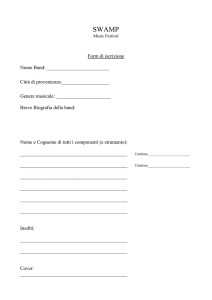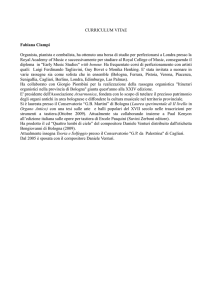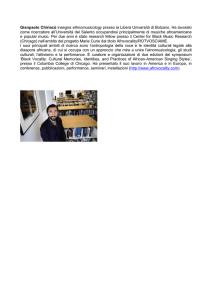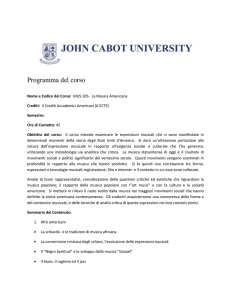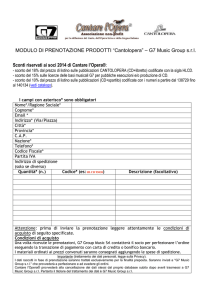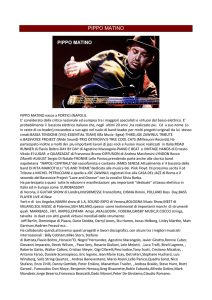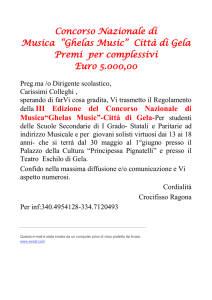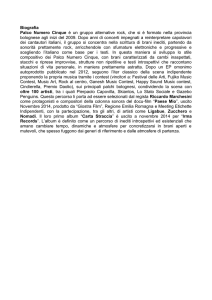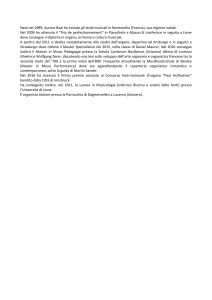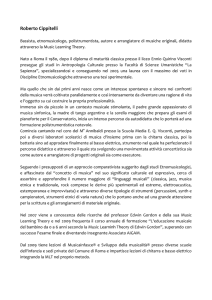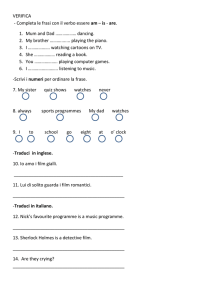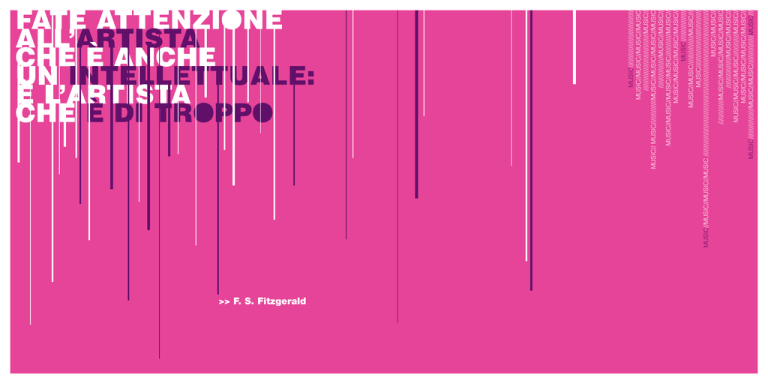
>> F. S. Fitzgerald
MUSIC/////////////////////////////////
MUSIC//MUSIC//MUSIC//MUSIC
/////////////////////////////////MUSIC//
MUSIC// MUSIC//////////////MUSIC//MUSIC//MUSIC//MUSIC
//////////////////MUSIC//MUSIC//
MUSIC//MUSIC//MUSIC//MUSIC/////////////MUSIC//
MUSIC//MUSIC//MUSIC//MUSIC//
MUSIC//////////////////
MUSIC//MUSIC/////////////////MUSIC///
MUSIC/////////////////////////////////
MUSIC//MUSIC//MUSIC//MUSIC ////////////////////////////////////////////////////////////////////////////////////
MUSIC//MUSIC//
//////////////MUSIC//MUSIC//MUSIC//MUSIC
//////////////////MUSIC//MUSIC//
MUSIC//MUSIC//MUSIC/////////////MUSIC//
MUSIC//MUSIC//MUSIC//MUSIC//
MUSIC//////////////////MUSIC//MUSIC/////////////////MUSIC///
FATE ATTENZIONE
ALL’ARTISTA
CHE È ANCHE
UN INTELLETTUALE:
È L’ARTISTA
CHE È DI TROPPO
music
214
MUSICIANS // DRAGAN RISTIC /
NEAT JUNUZI / DRAGAN
MITROVIC / DUSKO POPOVIC /
DJORDJE BELKIC / VLADAN
MITROVIC / DRAGAN RUNIC
SUBJECT: FOLK / ETHNO
(SCUOLA ESTIVA « AMALA » PER LA CULTURA E LA LINGUA ROM)
A Spirale nasce nel 2002
dall’incontro fra Maurizio
Argenziano e Massimo
Spezzaferro, chitarra e
batteria, Mario Gabola,
sassofonista e Anita Furlani,
violista. La musica suonata
alterna al suo interno
frammenti folclorici,
improvvisati, rock, rumoristici,
jazzistici ed elettronici.
Questa fase è documentata
dal disco “Come una lastra”
(Lizard, 2004). La band, dal
gennaio 2004, si presenta
nella formazione a 3
(batteria/chitarra/sax), e ha
suonato in vari festival
nazionali.
La musica di a spirale si
forma per accumulazione di
eventi sonori ordinati
emotivamente. L’intenzione è
quella di suonare un qualcosa
che si crei sempre
nell’istante in cui lo si sta
suonando, alternando sentieri
più noti con parti
improvvisate e lasciando che
a guidare il tutto sia il gioco di
rimandi fra suono ed
emozioni così da creare una
struttura sempre in
movimento. E’ una situazione
in cui il musicista mette in
gioco tutto se stesso e tutto
il suo bagaglio, per questo
nella musica di a spirale c’è
posto per incisi folk, sfuriate
free, stasi ambientali, fratture
post punk o ossessivo
minimalismo.
AMALA SUMMER SCHOOL FOR ROMANI
CULTURE
AND
LANGUAGE
NATION ROM
SUBJECT: FOLK / ROCK
A SPIRALE
NAPLES // ITALY
GUITAR // MAURIZIO
ARGENZIANO
SAX // MARIO GABOLA
DRUMS // MASSIMO
SPEZZAFERRO
A spirale was born in 2002,
when Maurizio Argenziano
and Massimo Spezzaferro
guitar and drums, met Mario
Gabola, sax , and Anita
Furlani, violist. Post-punk,
folk, noise, rock, electronic
music, r.i.o., free-jazz… the
music each member loves
influences the pieces and the
impros a spirale plays.
“Come una lastra” (Lizard,
2004) is the first band
release. Now the band is a
trio (guitar/sax/drums) and
with this line-up has played at
several Italian independent
rock festivals.
A Spirale music is formed
accumulating sound splinters
emotionally ordered. Our
intention is to play pieces
composing them while we
are playing, alternating
defined parts with improvised
sections, and leaving this
stream of sound to be
directed by the game of
interplay and emotions, to
create an ever changing
structure. This is a situation
in which the player is fully
involved with his immediate
present, playing, and with all
his past of memory and
suggestion... for this reason
in our music there is
incidental folk, free jazz, post
punk fractures, obsessing
minimalism and so on.
SUBJECT: FOLK / ETHNO
OUD/VOCE_OUD/VOCALS //
ZIYAD SAHHAB
PIANO // KHALED SOUBEIH
PERCUSSIONS // AHMAD
KHATEEB
QUANOON // GHASSAN SAHHAB
VOCALS // NADINE HASSAN
The group performs songs
and compositions from the
classical Arabic music
repertory and pieces of its
own members’ composition.
The objectives of the group
are to reactivate the classical
Arabic heritage (Turath), to try
to create a link between
Arabic youth and the Arabic
traditional music of 20th
century and to present new
compositions related to the
Arabic musical tradition.
The Beirut Group will soon
release its 1st album.
216
music
Le canzoni e le composizioni
suonate dal gruppo vengono
dal repertorio della musica
classica araba e alcuni pezzi
sono stati composti da
membri della band.
Gli obiettivi del gruppo sono
di riabilitare l’eredità araba
classica (Turath), di cercare di
creare un legame fra la
gioventù araba e la musica
tradizionale araba del 20°
secolo e, inoltre, presentare
nuove composizioni vicine
alla tradizione musicale araba.
The Beirut Group pubblicherà
presto il primo album.
BEIRUT // LIBAN
BEIRUT BAND FOR ARABIC MUSIC AND SONGS
SUBJECT: FOLK / ETHNO
AURELIO AND THE BIG BAND
NATION ROM
FAMIGLIA TANASE
Fanfare trascinanti e melodie
struggenti, valzer pomposi e
romantiche ballate: è la
musica Rom che con sempre
maggior irruenza riempie le
strade e i mezzi pubblici
d'Italia col suo universo di
emozioni e suggestioni.
Spesso ridotta a musica da
mendicanti e come tale
trattata, la musica rom ha
pervaso la storia musicale
dell'occidente senza che ne
resti memoria, da Liszt,
Brahms, Schubert,
Ravel, Debussy, Dvorak, per
finire a Goran Bregovich. E'
una musica dai tratti
dissonanti, malinconici, ribelli,
ma allo stesso tempo una
musica viva, briosa, piena di
ritmi incalzanti e di vita.
Nell'Europa Unita la musica
rom è simbolo spesso di
emarginazione con i musicisti
che suonano nei vagoni della
metropolitana e sui tram. A
gruppi di tre, quattro,
imbracciano il loro violino, la
fisarmonica, la chitarra
regalando sprazzi di colore e
gioia a città grigie fino a
quando la sorveglianza non li
blocca: rischiando
maltrattamenti e il sequestro
degli strumenti musicali.
La fisarmonica, il sassofono,
il contrabbasso e il violino
sono gli strumenti privilegiati
dal gruppo "Aurelio and the
big band", nato a Craiova in
Romania e oggi trasferitosi a
Milano.
La provenienza è Craiova, una
cittadina della Romania in cui
la comunità rom è dedita alla
costruzione di mattoni e ad
attività artistico-musicali.
Agli inizi degli anni novanta,
subito dopo la caduta di
Ceaucescu, a causa
dell'esclusione sociale, delle
precarie condizioni di vita
delle famiglie e con il
desiderio di trovare nuove
opportunità altrove, la
comunità ha iniziato un
progressivo esodo in diverse
direzioni: Germania, U.S.A.
ed infine anche l'Italia.
Nel 1985, Sabreen ha
raccolto quasi 20 bambini a
Gerusalemme, dando vita ad
un gruppo di bambini
chiamato Bidayat, che in
arabo significa “inizi”. Il
nome ricorda il processo
secondo il quale quei bambini
sono stati esposti alla cultura
e alla vita di un gruppo
musicale come punto di
partenza per lo sviluppo della
musica locale. Nel 2004,
sotto la guida di Wissam
Murad, Sabreen ha rinnovato
la tradizione dei Bidayat,
stavolta con un gruppo di
musicisti adulti, diplomatisi di
recente presso le istituzioni
musicali della zona.
Prima di andare in tournée
come gruppo, i musicisti
hanno partecipato a numerosi
programmi musicali della
comunità Sabreen, si sono
esibiti in varie scuole,
comunità e centri artistici dei
territori palestinesi, e nel
2004 si sono esibiti in diversi
festival di musica e cultura
locale.
Il repertorio di Bidayat è
composto da una fusione di
canzoni e pezzi strumentali
composti da compositori
famosi ma anche da una
selezione di canzoni di
Sabreen riarrangiate da
Wissam Murad. La
performance è una ricca
miscela di strumenti orientali
e occidentali, in un ambiente
che porta i due mondi a un
dialogo musicale.
In 1985, Sabreen gathered
close to 20 children in
Jerusalem and started a
children group that went by
the name Bidayat,
Beginnings in Arabic. The
name signifies the process
within which those children
were exposed to the culture
and life of a music group as a
spring point to local music
development. In the year
2004, and led By Wissam
Murad, Sabreen furthered up
the Bidayat tradition, this
time with a group of adult
musicians, recent graduates
of music institution in the
area.
Before it started touring as a
group, the musicians joined
several of Sabreen
community music program
and performed at several;
schools, community and art
based centers in the
Palestinian territories and
have performed in the year
2004 at several local music
and cultural festivals.
The repertoire of Bidayat
consists of a fusion of songs
and instrumentation of pieces
composed by renowned
composers as well as a
selection of Sabreen songs
that are rearranged by
Wissam Murad. The
performance is a rich blend
between oriental and
western instruments in an
ambience that brings the two
worlds in a musical dialogue.
218
music
SUBJECT: FOLK / ETHNO
MUSICIANS // JESSY
RAKOTOMANGA / GUILLAUME LYS
/ MICHEL GAGLIOLO
SINGER // MPHO SKEEF
SOUND TECHNICIANS // STEEF
BUS / GAËL BLONDEAU
BIDAYAT
JERUSALEM // PALESTINE
SUBJECT: DIGITAL
CHAMADE BEAT
TOULON // FRANCE
La musica di Chamade Beat
fluttua tra neo soul, hip-hop e
drum’bass, una miscela di
strumenti dal vivo e suoni di
musica elettronica. Il loro
album dal vivo "Sweat
Cinnamon & Chamade Beat"
trae ispirazione quasi
organica dalla musica soul.
Gli strumenti dal vivo
prendono il loro posto ancora
una volta senza sradicare i
campioni e gli altri suoni
generati sinteticamente. Le
loro voci morbide ricordano i
"soul brothers" degli anni
Sessanta: Marvin Gaye,
Stevie Wonder, Dionne
Warwick.
Chamade Beat's music
fluctuates between neo soul,
hip-hop and drum’bass, a mix
of live instruments and
electronic music sounds.
Their live album "Sweat
Cinnamon & Chamade Beat"
draws an almost organic
inspiration from soul music.
The live instruments take
their place again without
eradicating the samples and
other synthetically generated
sounds. Their smooth voices
are a reminder of the "soul
brothers" of the 1960's:
Marvin Gaye, Stevie Wonder,
Dionne Warwick.
MUSICIANS // WASSIM
ISSAQASSIS / CHARLIE RISHMAWI
/ MARYOU QUMSEYA / JOHN
HANDAL / MOHAMMAD NIJEM /
IBRAHIM NIJEM
SUBJECT: ROCK
MONSIEUR COCHON
LISBON // PORTUGAL
MURCIA // SPAIN
SUBJECT: FOLK / ETHNO
DIEGO CANTERO
music
Progetto aperto alla
collaborazione tra musicisti
con buone idee e che
condividono concetti e gusti
estetici identici. La base delle
canzoni consente loro di
esistere sotto forma di
cantautore, e allo stesso
tempo consente di dar vita ad
arrangiamenti strumentali che
danno luogo ad una
presenzaione più ricca e
musicalmente più complessa.
Ciò consente la realizzazione
di uno degli aspetti più
affascinanti della musica dal
vivo: l’adattamento di un
determinato progetto, e del
suo congiunto di musiche, ad
uno spazio e a un pubblico
che lo attende. Queste
quattro canzoni che oggi
vedono la luce del giorno
sono state registrate
d’intuito, senza regole né
spartiti, tentando
semplicemente di ottenere
un buon risultato sonoro
finale. Monsieur Cochon
riconosce la propria
ammirazione per i cantautori
(nazionali, brasiliani, britannici,
americani, francesi, vivi o
morti) e si lascia sedurre dalla
semplicità e dalla “musicalità
del rumore” del cosiddetto
rock alternativo/indie.
Project opened to the
collaboration among
musicians with good ideas
and that share identical
concepts/aesthetic tastes.
The base of the songs allows
them to exist in a singersongwriter format, although,
at the same time,
instrumental arrangements
may come up, resulting in a
richer and more musically
complex presentation. This
allows one of the most
fascinating aspects of
performed music: the
adaptation of a certain
project, and its set of songs,
to a space and an audience
awaiting them. These four
songs were intuitively
recorded, no rules or scores,
trying only to get a good final
result. Monsieur Couchon
assumes his admiration for
singer-songwriters [national,
Brazilian, British, American,
French, dead or alive] and
lets himself be seduced by
the simplicity and by the
“musicality of noise“ of the
so called alternative/indie
rock.
220
Ha raccolto così tanti premi e
riconoscimenti che faremmo
prima a citare le competizioni
e le gare alle quali non ha
preso parte. Ha viaggiato per
talmente tante città e
cittadine con la sua chitarra
che faremmo meglio a non
cominciare ad enumerarle. Il
segreto del suo successo
crescente (e apparentemente
senza limiti) è da ricercarsi
nel suo modo di interpretare
e nella peculiarità della voce,
nella sua perseveranza e
assoluta dedizione alla
musica, diretta e efficace,
nella sua grande lucidità
compositiva e nella
concezione della musica nel
senso più ampio, sempre
aliena da pregiudizi al
momento di comporre.
It has harvested so many
prizes and recognitions that
we would finish before he
we named the competitions
and contests in those that he
has not been present. He has
traveled with his guitar so
many towns and domestic
cities that better neither we
begin to enumerate them.
The secret of his strictly
growing success (and
without limit at sight) it
resides in his owns way of
interpreting and the
peculiarity of his voice, their
perseverance and absolute
dedication for the music, a
direct one really rolling, his
great lucidity to write and the
music's conception in wide
sense, always unaware to
any prejudice type when
composing.
MUSICIANS // JOÃO VEIGA /
ANTÓNIO PEDRO FIGUEIREDO /
PEDRO BALSE / PEDRO FARIA
GONÇALVES/ ZÉ PINTO /
FRANCISCO FURTADO
music
SUBJECT: CONTEMPORARY
The Europa Ensemble will
perform four composions by
Karl Fiorini. One of the works
“Les Voix Oubliées” will be
conducted by Bjørn Bantock.
MUSICIANS // ILIR A TOLAJ /
LUAN MACULA /
AGRON PENI / EDON RAMADANI /
XHEMIL GJINI
COMPOSER // KARL FIORINI
MUSICIANS // CARINA
ALBUQUERQUE / LUISA ROSINA /
AISA IJIRI / BJORN BANTOCK /
JOSE ZALBA / STEVEN BURKE /
PAOLA CABALLERO
222
L’Europa Ensemble
eseguirà quattro composizioni
di Karl Fiorini.
Una di queste opere,
“Les Voix Oubliées”, sarà
diretta da Bjørn Bantock.
PENBROKE // MALTE
EUROPA ENSEMBLE
Ethnically Plugged is a new
formed band from some of
the best musicians in
Kosovo.
They call their music as a
Ethno Ambient Jazz.
SUBJECT: ETHNO AMBIENT JAZZ
ETHNICALLY PLUGGED
PRISHTINA // KOSOVO
Ethnically Plugged è una
band di nuova formazione
che raggruppa alcuni dei
migliori musicisti del Kosovo.
Definiscono la loro musica
Ethno Ambient Jazz.
Ganjazz è una band che
nasce dall'amicizia fra i
musicisti che la compongono
e dallo speciale feeling
creativo che si è creato tra
loro. I concerti di GanJazz
sono pieni di groove e di
ritmi. Una band nata nel
2002, suonando soltanti pezzi
strumentali fino all'ingresso
nella band di Alex
Domínguez, cantante e dj. I
pilastri ritmici di GanJazz
sono il basso e le
percussioni. Le due chitarre
seguono strade decisamente
diverse: mentre una suona
essenzialmente jazz l'altra
vibra alla maniera di Jimi
Hendrix. Il flautista guida il
gruppo con le sue melodie.
Ma la voce è il legame finale,
con testi freschi e positivi.
224
MALAGA // SPAIN
music
CLARINET // PECE NIKOLOVSKI
VOICE // BRANISLAV NIKOLOV
ORGAN // PETAR DIMITROVSKI
ACCORDION,AC. GUITAR // PECE
TRAJKOVSKI
DOUBLE BASS // GOCE
JOVANOVSKI
DRUMS // SLAVCO JOVEV
SUBJECT: FOLK / ETHNO
GANJAZZ
FOLTIN
SKOPJE // FYROM
SUBJECT: FOLK / ETHNO
Il gruppo è stato fondato nel
1995 e ha pubblicato tre
album: Outre – Mer,
Archimed e Donkey Hot. Il
quarto, intitolato Lo – Lee –
Ta – Too sta per uscire.
Dal 1999 creano e suonano
inoltre musica e colonne
sonore per il teatro, per
iniziative nazionali.
Ogni tentativo di etichettare
questo gruppo è destinato a
fallire. Nonostante l’uso di
strumentistica consolidata, il
loro approccio alla
costruzione del suono e
dell’atmosfera è
imprevedibile e
estremamente originale,
quindi è impossibile
paragonarli con qualsiasi altra
espressione musicale
nazionale o mondiale.
I testi sono scritti in una
lingua originale: un’imitazione
fonetica o una mescola
fantasiosa di più lingue
mondiali (spagnolo, francese,
rumeno, portoghese...)
Hanno suonato con successo
a livello sia nazionale che
internazionale in molte
occasioni come
il DNEVI MAKEDONSKE
KULTURE V SLOVENIJI, al
Castello di Vogrsko a Nova
Gorica, Slovenija e al OHRID
SUMMER FESTIVAL, St.
Sofia, in Macedonia nel 1997.
Nel 2000 hanno partecipato
a: NEW AGE a Skopje,
Macedonia; AQUARIUA ERA
– Festival del nuovo oriente –
in Bulgaria; TONI CORTI a
Padova, Italia; BELGRADE
SUMMER FESTIVAL a
Belgrado, Serbia;
MACEDONIAN OPEN
FESTIVAL a Skopje,
Macedonia; al BEOGRADSKO
NARODNO POZORISTE a
Belgrado, Serbia.
The group exists since 1995
and so far they've published
3 albums: Outre – Mer,
Archimed e Donkey Hot. The
fourth Lo – Lee – Ta – Too is
on the way.
Since 1999 they hare also
created and performed music
and sound design for theatre,
for national events.
Every attempt to label this
group is a failure. Despite the
fact that they are using
established musical
component, their approach of
building the sound and the
atmosphere is unpredictable
and extremely original, so it
is impossible to compare
them with any home or world
musical expression.
The lyrics are in authentic
language: phonetic imitation
or imagination mixture of
different world languages
(Spanish, French, Romanian,
Portugal…)
Except in Macedonia they
have successfully entertained
in DNEVI MAKEDONSKE
KULTURE V SLOVENIJI at
the Vogrsko Castle, Nova
Gorica, Slovenija and in
OHRID SUMMER FESTIVAL
in St. Sofia, Macedonia in
1997.
In 2000 they participated to :
NEW AGE in Skopje,
Macedonia ; AQUARIUA ERA
– Festival of new east – in
Bulgaria ; TONI CORTI in
Padova, Italy ; BELGRADE
SUMMER FESTIVAL in
Belgrade, Serbia ;
MACEDONIAN OPEN
FESTIVAL in Skopje,
Macedonia ; BEOGRADSKO
NARODNO POZORISTE in
Belgrade, Serbia
GanJazz is a band that leans
on all members beings
friends and the special
creative feeling born among
them. GanJazz's live shows
are packed with grooves and
rythms. The band was born
in 2002, starting to play
instrumental songs until Alex
Domínguez joined in as
singer and dj. The solid
bassement of the band are
the bass and the drums. The
guitars are totally different:
one of them plays jazz and
the other sounds the way
Jimi Hendrix did. The flute
player drives the group along
with his melodies. The voice
is the final link, with fresh
and positive texts.
GUITARS // ANTONIO TORRES
AVILÉS / LUCAS CASTAÑO
SÁNCHEZ
FLUTES // ADRIÁN SANTOS
LLAURADO
BASS // EMILIO JOSÉ MÁRQUEZ
RODRÍGUEZ
SINGER AND DJ // ALEJANDRO
DOMÍNGUEZ CUESTA
DRUMS // JOSÉ MARÍA CALVO
SÁNCHEZ
BELGRADE // SERBIA MONTENEGRO
SUBJECT: JAZZ
MUSICIANS // FILIPPO BRILLI /
TIZIANO CANCIALLI / FRANCESCO
FROSINI / LUCA GIROTTI / LUCA
ROMANELLI / ALBERTO ROSSI
ASSISTANT // VALENTINA RUSSO
SEX MACHIGNO
The work “Sex Machigno”
wants to propose itself as
the beginning of a new
approach to music and its
styles. It's an attempt to find
a link among different
musical traditions, making
experiments with rhythm
structures and typical
features of single styles
without losing the original
value and catchiness of each
one of them. The result is a
medley of quotations and
different styles, completed
by the funny attitude of the
band, both on records and
live gigs. On the stage, the
band presents a crazy show,
with comic interludes,
quotations, jam-oriented, and
often integrated with
videoclips.
JASNA & BALKANESKA
SUBJECT: JAZZ
music
Il gruppo Jasna & Balkaneska
è stato fondato quasi tre anni
fa da Jasna Jovicevic nel
contesto dell’Accademia
musicale Franz Liszt di
Budapest. Tutti i componenti
del gruppo erano studenti di
quella scuola.
Il gruppo ha cominciato ad
arrangiare canzoni folk a
modo suo, portando elementi
jazz in quelle canzioni, ma
ben presto ha scelto di
comporre musica propria, con
stile e immagine propri.
Jasna, nata e cresciuta in
Serbia, ha composto la
maggior parte del repertorio
del gruppo. La sua idea è di
avvicinare la gente
all’essenza della musica
tradizionale, contaminandola
con altri linguaggi musicali
quali il jazz e la musica
contemporanea.
Anche le orchestrazioni sono
una fusione tra vecchio e
nuovo mondo.
Jasna & Balkaneska sono ben
conosciuti dal pubblico
ungherese e serbo.
Hanno suonato nei più grandi
festival jazz e mondiali quali:
Budapest Jazz Festival, Open
Jazz Days di Zsambek, Live
at Bartok National Radio, Spin
Festival, Subotica Parlament,
BalkanArt Festival di
Ljubljana, Etno Music
Competition di Milano.
Il gruppo progetta di
comporre altra musica nuova,
di incidere un disco e di
incontrare il nuovo pubblico
europeo.
226
PRATO // ITALY
IL COMUNE SENSO DEL RUMORE
SEX MACHIGNO
L'opera “Sex Macigno”
vuole proporsi come
manifesto di un approccio
nuovo ai generi e agli stili
musicali. Il tentativo è quello
di accostare tradizioni
musicali lontane e di giocare
con le strutture ritmiche e
tematiche che caratterizzano i
generi senza snaturarne il
valore e l'orecchiabilità. Il
risultato è un gioco di
citazioni e riferimenti a cui fa
da collante l'atteggiamento
divertito del gruppo sia su
disco che nelle esibizioni live.
Dal vivo il gruppo propone
uno spettacolo surreale, con
intermezzi cabarettistici e
citazioni, aperto a
collaborazioni e integrazioni
con video-proiezioni.
Jasna & Balkaneska exists
almost 3 years, former Jasna
Jovicevic put this band
together on Franc Liszt Music
Academy in Budapest. All the
members were the students
on that school.
It started with arranging the
folk songs on own way,
bringing some jazz world into
it,but soon, they choosed to
make own music with
original face and style.
Jasna compose the most of
their repertor, who was born
and grown up in Serbia. Her
conception is to bring close
to the people the essence of
traditional music, mixed with
other music languages as jazz
and contemporary music.
Also the orcestrations are the
fusion of old and the new
world.
Jasna & Balkaneska is well
known to Hungarian and
Serbian audience.
They played on the biggest
Jazz and World music
festivals as Budapest Jazz
Festival, Open Jazz DaysZsambek, Live at Bartok
National Radio, Spin Festival,
Subotica Parlament,
BalkanArt Festival- Ljubljana,
Etno Music CompetitionMilan.
The plan of the band is to
make more new music, to
make a record and meet the
new european audiance.
MUSICIANS // JASNA JOVICEVIC /
ATTILA BLAHO / HORVATH
ANDOR / SZABO HUNOR
SINGER // EVA BOLBA
RIJEKA // CROATIA
SUBJECT: ELECTRONIC
MÉKANIK KANTATIK
una creazione visiva e
musicale per la quale ha
tratto ispirazione da una
miscela di jazz e musica
contemporanea e che risiede
in una trasversalità tra suono
e video gestiti in tempo reale
utilizzando vari processi
interattivi. Il risultato è un
confronto tra l’acustico e il
digitale, tra il tradizionale e il
moderno, l’umano e il
robotico. Questo spettacolo
dal vivo attiva un universo
sonoro vicino alla sfera di
Monk, atmosfere degne di
John Cage, arricchite con
melodie popolari
destrutturate e tocchi
pianisticamente modificati di
swing, tutto in tempo reale.
MÉKANIK KANTATIK
a musical and visual creation
for which he drew his
inspiration from a mixture of
jazz and contemporary music,
and which resides in a
transversality between sound
and video, managed in real
time using various interactive
processes.The result is a
confrontation between the
acoustic and the digital, the
traditional and the modern,
the human and the robotic.
This live show activates a
sonic universe close to the
“Monkian” sphere,
atmospheres worthy of John
Cage, enriched with
destructured popular
melodies, and pianistaically
modified touches of swing,
all in real time.
LABOSH
SUBJECT: CONTEMPORARY
AIX EN PROVENCE // FRANCE
PIANO MÉKANIK KANTATIK
METODO DI
DISUMANIZZAZIONE
Method of Dehumanization è
un esperimento sonoro
basato sulla tradizione
europea del “giradischismo”.
Questo progetto
sperimentale si basa sullo
sviluppo di una fonte nuova e
inesauribile di ripetizione
infinita della frase (loop) alla
fine della registrazione di
ciascun brano/disco
fonografico, quale unità base
di musica elettronica,
manipolandola poi con i
principali strumenti del DJ. La
parte di disco di cui sopra
non reca inciso alcun suono
ed è risultato esclusivo del
processo di produzione del
disco. Poiché questa parte
della registrazione non rientra
nel campo del diritto d’autore
che tutela il contenuto audiovisivo di un disco, questo
progetto costituisce anche
una provocazione riguardo
all’inflessibilità dei metodi
attuali di tutela del diritto
d’autore. Questo album è
pubblicato secondo la licenza
Creative Commons e rivela
un metodo che può essere
utilizzato da chiunque
nell’industria della musica
(Metodo). Questo materiale è
considerato da Labosh come
“inascoltabile” e in quanto
tale rappresenta una critica
alla maggioranza dei
meccanismi attuali di
creazione, presentazione e
consumo della musica
“techno” e allo stesso tempo
è una critica nei confronti di
se stesso in qualità di
produttore, DJ e
consumatore. Di qui la
Disumanizzazione.
music
228
MUSICIANS // NICOLAS CANTE /
ALEXANDER ALTAIN ALDEA /
GILLES TOUTEVOIX
METHOD OF
DEHUMANIZATION
Method of Dehumanization is
a sound experiment based on
tradition of European
"Turntableism". This
experimental project is based
on devising a new and
inexorable source of loop
(endlessly repeated phrase)
at the end of cut/recording of
each gramophone record as a
basic unit of electronic music
and its manipulation using
basic DJ tools. The referred
to part of a record bears no
sound recording, and is an
exclusive result of a record's
manufacturing process. As
this part of the recording is
not in the domain of
copyrights protecting audiovisual content of a record,
this is a reason why this
project also provokes
inflexibilities of the existent
mechanisms of copyright
protection. The album is
published under a Creative
Commons License and
discloses a method that can
be used by anyone in the
music making business
(Method). This material is
considered by Labosh
"unlistenable" and as such
presents a critique of the
majority of existing
mechanisms of creation,
presentation and
consummation of "techno"
music and simultaneously a
critique of himself as a
producer, DJ and consumer.
Hence Dehumanisation.
ˇ
AUTHOR // LABOSH VISESLAV
ˇ (WHITH VJ EIRENAH)
LABOS
VJ // EIRENAH IRENAH ANDREIÇ
SOUND TECHNICIAN // TOMISLAV
GJERGJA AKA T_LIVE
CERCHIO ROSSO:
TECNOLOGIA
SENTIMENTALE
Musica per un night-club
E quando balliamo, cosa resta
dei movimenti rituali
ancestrali, della massiccia
passione della folla? Se la
luce forma uno schermo
protettivo alle spalle del quale
il pubblico si raccoglie in una
posizione comune – non
isolamento ma
partecipazione. Con il vago
movimento individuale.
“D’improvviso, i germogli
delle vigne e delle edere
rampicanti cominciano ad
allacciarsi da qualche parte,
rubinetti che scorrono ecc.
Dio è qui” “Mitologia greca”,
Volume 2, pag. 323, Ekdotike
Athenon SA 1986
230
music
SUBJECT: DIGITAL
Le Lavatrici Rosse (The red
washing machines)
Andrea Beccaro (drums,
sampler) and Riccardo
Ruggeri (voice, loop machine)
met in 2001, coming from
different experiences.
After recording a free
improvisation in April 2002
they decided to compete at
the ” Percfest – Festival delle
percussioni” where, to their
surprise, won the first prize.
This led to a series of
concerts and performances
(the project won the award
“Premio Aosta Classica” in
August 2002) in which they
had the chance to expand
and refine their vocabulary,
sometimes improvising freely
at a contemporary art
exhibition, sometimes trying
to meet the expectations of a
groove-hungry rave party-like
audience.
As a “drums/voice/electronics”
duo they have no precedent,
so their aim consist in
pushing the boundaries of
the instrument as known and
create for themselves a
whole new set of musical
expressions.
Influences: King Crimson,
ancient italian folk music,
Edgard Varese, Bobby
McFerrin, John Coltrane,
Luciano Berio, Nine Inch
Nails, Bela Bartok, Zakir
Hussain…
After winning, in June 2004,
the competition
“Demetrialmente – Omaggio
a Demetrio Stratos” they
recorded and published their
first cd “Le Lavatrici Rosse”.
Along with Andrea Manzoni
(piano) and Luca Bertinaria
(acoustic bass) they form the
quartet Lomè (www.lome.it) .
Their first cd “Fiori su Marte”
(July 2004) is published by
the label Leubage.
ESTHER LEMI
ATHENS // GREECE
TURIN // ITALY
SUBJECT: CONTEMPORARY
LE LAVATRICI ROSSE
Le Lavatrici Rosse nascono
nell'Aprile 2002 dall'incontro
del batterista Andrea Beccaro
con il cantante Ruggeri
Riccardo.
Con la prima registrazione
effettuata a fine Aprile
accedono alle finali del
concorso nazionale “Percfest
2002” svoltesi a Laigueglia a
fine Giugno. Il brano
presentato alle selezioni del
concorso consisteva in una
performance di musica
improvvisata, vista come
composizione istantanea, con
uso non convenzionale degli
strumenti. La voce è stata
impiegata in due modalità,
una basata sull'imitazione del
suono di strumenti
percussivi, l'altra sull'uso
ritmico del suo stesso suono
naturale. La batteria, invece,
è stata usata come fonte
inesauribile di suoni e colori
mediante l'impiego di
tecniche non convenzionali e
battenti diversi in una
continua ricerca timbrica,
ritmica e melodica. Sono stati
usati inoltre campionatori e
loop machine.
Altro elemento fondamentale
del lavoro presentato è stata
la rielaborazione dei diversi
generi musicali, dal jazz
all'etnico, dal rock al
rumoristico, esposti con
coerenza senza banali
folklorismi.
Grazie a questo lavoro i due
musicisti si sono aggiudicati il
primo premio al concorso
Percfest 2002, il “Premio
Aosta Classica 2002” e un
concerto all'interno della
stessa rassegna Aosta
Classica.
Nell'autunno dello stesso
anno hanno partecipato alla
manifestazione
“Convergenze” a Biella,
presso la fondazione
Pistoletto, con una
performance di musica
improvvisata.
Dall'esperienza live è stata
ricavata una prima
registrazione nella quale non
vengono smentite le
ambizioni iniziali del progetto
di ricerca, esplorazione,
rielaborazione e creazione del
mondo sonoro nella sua
interezza, sia quello proprio
degli strumenti usati, sia
quello che circonda e
interagisce con l'esistenza di
ognuno. Riscoprire le qualità
primarie del suono e dei
mezzi che ne permettono la
nascita e lo sviluppo, un
percorso verso la
decostruzione dei tradizionali
canoni estetici e uno stimolo
per un ascolto intelligente.
L'uso della tecnologia come
mezzo, come supporto per
oltrepassare i “limiti” degli
strumenti primari, si sposa
con il suo opposto, con
l'improvvisazione, atto
viscerale ed irripetibile.
Un ulteriore sviluppo del
progetto è stato presentato
all'interno della rassegna
“Suoni del nuovo millennio”
presso il “Sound Town” di
Torino. Nel gennaio 2004
viene inciso il primo disco
autoprodotto “le Lavatrici
Rosse”, uscito poi a
dicembre dello stesso anno.
Nel frattempo, tra le attività
più importanti, ci sono la
vittoria del concorso
“Omaggio a Demetrio
Stratos 2004” e la
partecipazione alla rassegna
di arte contemporanea
BIARTECA tenutasi a
Rosazza a Luglio.
Al momento le Lavatrici
Rosse stanno valutando
alcune proposte di
distribuzione e sono state
selezionate per la Biennale di
Napoli 2005 in
rappresentanza del Piemonte
per la sezione musica.
RED CIRCLE:
SENTIMENTAL
TECHNOLOGY
Music for a night-club
And when we dance, what is
left from the ancestral ritual
movements, the massive
passion of the crowd?
Whether the light forms a
protective shield behind
which the audience is
gathered in a common
position - not isolation but
participation. With the vague
individual movement.
“Suddenly, sprouts from
climbing vines and ivies start
to entangle in some place,
running taps etc. God is
here” “Greek Mythology”,
Band 2, pg.323, Ekdotike
Athenon SA 1986
SINGER // RICCARDO RUGGERI
MUSICIAN // ANDREA BECCARO
MUSICIAN // ESTHER LEMI
VISUAL SUPERVISOR // EUGENIA
LAMBRINIDOU
music
232
SUBJECT: ROCK
DAMASCUS // TUNISIE
MUSICIAN // ALESSANDRA FALCA
VISUAL SUPERVISOR // MAURIZIO
MUZZI / ELENA MELLINO /
DOMINICI EMILIANO /
FRANCESCA BIANCHI / KATIA
CIANCI
MADSHOCK
SUBJECT: POP
LIVORNO // ITALY
LOUNGERIE
Lo spettacolo è
prevalentemente brillante,
composto da parti cantate
intermezzate da brevi
dialoghi. L'intenzione è quella
di ricreare un salotto
immaginario ai bordi della
strada con suggestioni che
ricordano la televisione
italiana degli anni '70, i jingles
pubblicitari americani degli
anni '50/60, il cabaret e
l'avanspettacolo con le varie
macchiette. I personaggi
interagiscono tra loro e con il
pubblico, rivisitando in chiave
ironica i vari stereotipi e le
contraddizioni dell'epoca
moderna. Il progetto nasce
dalla stesura di alcune nostre
canzoni inerenti a questo
tema. La ritmica dei pezzi è
sostenuta da cori, giochi
vocali, rime e piccoli
strumenti pseudomusicali,
come lo shaker o una lamina
di ferro per simulare le
perturbazioni atmosferiche. I
dialoghi sono costruiti alla
maniera delle vecchie
reclames, attraverso nonsense e giochi di parole. Le
frasi rimbalzano velocemente
da un personaggio all'altro,
creando una sensazione di
vertigine nel pubblico.
La prima cantante, vestita in
maniera molto appariscente,
ricorda il personaggio della
sciantosa dell'avanspettacolo.
Il coro è composto da tre
clown: un bianco che dirige
gli altri due. Insieme creano
gags e coreografie durante
tutto lo spettacolo,
intralciando la prima cantante
che tenta di interpretare al
meglio i suoi pezzi da solista.
La chitarrista interagisce col
resto del gruppo lanciando i
temi e le presentazioni dei
vari pezzi. I personaggi sono
tutti vestiti in modo elegante
e colorato, e bevono acqua blu.
The show is mostly witty and
comic, made of original
songs and short dialogues.
The aim of the show is to
recreate an imaginary living
room at the side of the road
(or stage), reminding the
cabaret, the Italian TV of the
60s and 70s, the American
jingles of the 50s, the
comedy of art with its
different personalities. The
actors interact with them and
with the audience, rivisiting
the stereotypes of the
modern age from an ironic
point of view.
The songs are enriched by
vocal games, puns, rhymes,
gags, silly dances and some
pseudo-musical instruments.
The dialogues are built like
old “reclames”, through
nonsenses and word games.
The sentences bounce
quickly from one character to
another, causing a sensation
of dizziness in the audience.
All characters are well
dressed, in a colourful and
elegant way, vaguely inspired
by the fashion of the 50s and
60s; and they all drink blue
water.
MUSICIANS // HAMMADI
GUERMAZI / NADIM BEN TARA /
SAMI KHOUJA / SOUFIANNE
MAHJOUB / ZIYAD KHALGUI
234
music
SINGER // NICOLA DELLA VALLE
MUSICIANS // FRANCESCO SANCISI /
ANDREA MARCO POLLICE / PAOLO
MACINA / GIANLUCA CAPELINI
The songs were written
using a hardware sequencer
[Rm1x], the recording results
from controlling the
sequencer in real time and
from synthesizer
manipulation. The result was
recorded in a computer using
the ProTools system.
Le canzoni sono state scritte
usando un sequenziatore
hardware [Rm1x], l’incisione
risulta dal controllo del
sequenziatore in tempo reale
e dalla manipolazione del
sintetizzatore. Il risultato è
stato registrato in un
computer usando il sistema
ProTools.
SUBJECT: DIGITAL
MI ODIO
With this work, we have tried
to go beyond music and
create an audio-visual opera
able to entertain the
spectator in a complete way
and stimulate him/her
emotionally. We have
constructed a sort of videoclip, which skims the
different forms of Passion,
and is able to accompany and
integrate our electro-pop
sounds. It represents the
mirror of the world in which
we live, that reality everyone
tries to ignore but which
inexorably belongs to us.
MOON
1010
LISBOA // PORTUGAL
SUBJECT: ROCK
SAN MARINO // REP. SAN MARINO
MIODIO
MI ODIO
Con questo lavoro abbiamo
cercato di spingerci oltre alla
musica, creando un'opera
audio-visiva che potesse
intrattenere lo spettatore in
modo completo, stimolandolo
emotivamente. Abbiamo
costruito una sorta di videoclip, che sfiorasse le diverse
forme di Passione, e che
potesse accompagnare ed
integrare le nostre sonorità
elettro-pop. Rappresenta lo
specchio del mondo in cui
viviamo, quella realtà che tutti
cercano di ignorare ma che
inesorabilmente ci appartiene.
MUSICIANS // MUSICISTI JOSÉ
FERREIRA / HELENA JOANA
HENRIQUES
MUSICIANS // BEN SAHLI
MOURAD / KERRI MEHDI
NAPLES // ITALY
MUHE
The band, set up in 2005, is
made up of two musicians:
Ben Sahli Mourad
and Kerri Mehdi.
Ben is 24 years old and is a
percussionist. He was a
member of the following
bands: Zalathoustra, yakem,
Thaoura, Tooklao, Kif-H,
Eclipse. Currently he plays
with Mouhdi, Safari, Diwan e
Dzair. He performed at
concerts at Ibn Zeydoun, Les
beaux-arts d’Alger, the Riad
El Feth strip and Ibn
Khaldoun.
Kerri is 26 years old and plays
the guitar. He was a member
of the following bands: Slam,
El-Rimmel, Arak, Eclipse, KifH. He took part in numerous
concerts and festivals at Ibn
Zeydoun, Afrik, “Les beauxarts d’Alger”, Kazif,
l‘Astrolabe and Ibn Khaldoun.
SUBJECT: ELECTRONIC
IAME
Muhe è un progetto di
musica elettronica di scuola
tedesca nato nel 2003, dalla
mente gioviale, malinconica e
fanciullesca di Luigi Cozzolino.
Tra il 2004 e 2005 Luigi
Cozzolino suona con Tujiko
Noriko, Tarwater, Ikue Mori e
Zeena Parkins, Retina,
Giardini di Mirò, Vanishing.
Finalista di Progetto Demo
2004 e del Six Day Sonic
Madness 2005.
Muhe è un progetto
electonic glitch (indie-tronica).
Synth, laptop and loops sono
usati per la creazione di un
tessuto sonoro intriso di
sonorità Morr Music, dai Lali
Puna ai Mùm ai Sigur Ròs:
un vero e proprio viaggio nei
sogni dei bambini.
MUSICIANS // LUIGI COZZOLINO /
TIZIANA SCOGNAMIGLIO / ILARIA
SCARICO
VIDEO MAKER // MICHELE CIRO
FRANZESE
IAME
Muhe is a German-school
electronic music project born
in 2003 from the joyful,
melancholic and childish
mind of Luigi Cozzolino. In
2004 and 2005, Luigi
Cozzolino played with Tujiko
Noriko, Tarwater, Ikue Mori
and Zeena Parkins, Retina,
Giardini di Mirò, Vanishing.
He was a finalist at the
Demo Project 2004
and at the Six Day Sonic
Madness 2005.
Muhe is an electronic glitch
project (indie-tronic). Synth,
laptop and loops are used for
creating a dreamlike
atmosphere drawing
inspiration from Morr Music
sound, from Lali Puna to
Mum and Sigur Ròs: an
absolute trip in children’s
dreams.
236
music
SUBJECT: WORLD MUSIC
ALGER // ALGERIA
MOUHDI
Il gruppo, formatosi nel 2005,
è composto da due musicisti:
Ben Sahli Mourad
e Kerri Mehdi.
Ben ha 24 anni, ed è un
percussionista. E’ stato
membro dei gruppi:
Zalathoustra, yakem,
Thaoura, Tooklao, Kif-H,
Eclipse; attualmente suona
con Mouhdi, Safari, Diwan e
Dzair. Ha partecipato a
concerti a Ibn Zeydoun, a
“Les beaux-arts d’Alger”, alla
spianata di Riad El Feth e
nella Ibn Khaldoun.
Kerri ha 26 anni ed è un
chitarrista. E’ stao membro
dei gruppi: Slam, El-Rimmel,
Arak, Eclipse, Kif-H. Ha preso
parte a vari concerti e
rassegne a Ibn Zeydoun,
Afrik, “Les beaux-arts
d’Alger”, Kazif, l‘Astrolabe e
Ibn Khaldoun.
SQUARE
Gli Op*ac sono un giovane
gruppo dalla geometria
variabile (da 2 a 23 persone)
con un vasto repertorio che
varia dal jazz alla acousmatic,
alla contemporanea, dal rock
al pop. Gli Op*ac coinvolgono
il pubblico con esperimenti
scenografici e visivi,
inseparabili dall’evento
musicale. Nelle loro
esibizioni, la musica – al
tempo stesso avvolgente ed
aggressiva, contemplativa e
vendicativa – è il cuore di una
performance pluralistica che
mette in moto luci, proiezioni,
colori, fumo e perfino gli
spettatori, in uno spazio in cui
vengono recitati i fondamenti
dell’umanità: vita, morte,
passioni.
Lo spettacolo presentato alla
Biennale, Square, è un
dispositivo aperto in seno ad
una comunità di individui
(musicisti, operatori,
spettatori…) mirato, grazie
alla loro interazione, a
modificare o amplificare una
situazione già esistente. Lo
scopo del progetto non
risiede soltanto nell’ascolto
passivo ma nell’interazione
tra attori, uditori e sistemi, e
propone una deambulazione
nello spazio piuttosto che la
messa in scena di percezioni.
SQUARE
Op*ac are a young group of
variable geometry (from 2 to
23 people) with a vast
repertoire, covering jazz,
acousmatic music,
contemporary music, rock or
pop. Op*ac attract the public
by means of scenographic
and visual experiments,
which are inseparable from
the sound event.
In their shows the music – at
once embracing and
aggressive, contemplative
and vengeful – is the heart of
a pluralistic performance that
sets everything in motion:
lights, projections, colours,
smoke, and even the
spectators, in a space where
human essentials are played
out: life, death, the passions.
The show presented at the
Biennale, Square, is an open
device in the heart of a
community of individuals
(musicians, cameramen,
spectators…) aimed at
changing or amplifying an
already existing situation,
thanks to their interaction.
The purpose of this project is
not only about passive
listening but also about
interaction between actors,
audience and systems; it
proposes to walking about
the space rather than the
mise-en-scène of
perceptions.
MUSIC_INSTALLATION_
DEVELOPMENT // MATTHIEU
VOIRIN
DIGITAL PAINTING_INSTALLATION //
STEVE STUART / ARIE VAN
EGMOND
SELF MADE INSTRUMENT //
SEBASTIEN RAYMONDO
GUITAR // MARC LAPEYRE
CELLO // CAMILLE GUILLARDIS
PROGRAMATION MAX MSP //
TAREK ATOUI
SOUND & VISUAL WORKS //
MARILINE FIORI
238
music
SUBJECT: CONTEMPORARY
SINGER // PÉREZ-CARRO
SÁNCHEZ MARCOS
MUSICIAN // RODRÍGUEZ AROCA
CRISTOBAL / NAVARRO SÁNCHEZ
GONZALO / PÉREZ RIPIO
ALFONSO / PASTOR ROSKOTEN
LUIS / MARSILLA SOLER PEPE
OP*AC
MARSEILLE // FRANCE
SUBJECT: ROCK
MURCIA // SPAIN
NAHIA
Al momento attuale paiono
imporsi come i nuovi leader
della movimentata scena
MMM (Murcia Modern
Metal), sebbene si discostino
stilisticamente dal metallo
puro e dal percorso nu-metal
per autoetichettarsi all’interno
della corrente del metal
alternativo. E quando
parliamo di questa
sconcertante etichetta ci
riferiamo esattamente a un
riuscito cocktail del miglior
rock alternativo, con lampi del
già citato nu-metal e una
ricaduta più melodica tipica
dell’hardcore. Per avere
un’idea dell’amalgama sonora
di marca Nahia, possiamo
alludere a influenze più o
meno meridiane di gruppi
come Rage Against The
Machine, Smashing
Pumpkins, Tool, Incubus,
Deftones, Glassjaw o Minus
The Bear. Nemmeno a dirlo,
shakerando con cura questo
cocktail i Nahia danno vita a
un nettare dal sapore
francamente ricco e
personale.
At the present time they
seem to be erected as the
new leaders of the rocking
scene MMM (Murcia Modern
Metal), although, they are
unmarked stylistically of the
pure metal and of the
appealed nu-metal and they
pass to auto-label inside the
current of the alternative
metal. And when we speak
of that disconcerting label we
are in fact referring to a good
cocktail of the best
alternative rock, with lashes
of the mentioned nu-metal
and the most melodic slope
in the hardcore. So that they
are made a previous idea of
the sound amalgam that
Nahia bills, we can make
allusion to approximately
meridian influences of such
bands as Rage Against The
Machine, Smashing
Pumpkins, Tool, Incubus,
Deftones, Glassjaw or Minus
The Bear. Neither what to say
has that of the hit upon
agitation of that cocktail,
Nahia believes a nectar with
a frankly rich and personal
flavor.
240
music
MADRID // SPAIN
SUBJECT: POP
LUIS VICENTE RAMIRO
SUBJECT: FOLK / ETHNO
STRUMICA // FYROM
ORKESTAR VELINCI
SAXOFON // REDZEP MEMEDOV
KONTRABAS // NEBUS KURTOV
DRUM // SERIV DEMOV
TRUMPET // ISIN AGUSHEV /
ALI MEMEDOV
BARITON // TEFIK ASANOV /
NEJBI KURTOV
MI VECINA DE ENFRENTE
(LA MIA VICINA DI
FRONTE) E DOS COPLAS
(DUE CANZONI)
Luis Vicente Ramiro nasce
nel quartiere madrileno di San
Cristòbal di Los Angeles.
Comincia a dedicarsi alla
musica a vent’anni, entrando
a far parte di vari gruppi di
stili diversi, fino a che, due
anni fa, all’età di 25 anni,
decide di cantare in proprio le
sue canzoni. Oggi suona in
locali quali il Galileo Galilei,
Libertad 8 o Clamores, punti
di riferimento per il mondo
dei cantautori. Pur non
avendo ancora inciso un
disco e con appena due anni
di esperienza alle spalle, la
sua musica si è diffusa e
viene suonata nei circuiti dei
cantautori di tutta la Spagna e
in paesi come il Messico e
l’Argentina. Cantautori famosi
come Tontxu, Hilario
Camacho o Alberto Péres (La
Mandràgora) hanno suonato
con lui in alcuni dei suoi
concerti. Questo è il primo
concorso al quale partecipa.
MUSICIANS // LUIS VICENTE
RAMIRO / MARWAN ABU-TAHOUN
RECIO / DAVID FERNÁNDEZ
CALLEJA / PEDRO BARRIGA
HERNANDEZ
MI VECINA DE ENFRENTE
(MY SHE-NEIGHBOUR
LIVING OPPOSITE ME) E
DOS COPLAS (TWO
SONGS)
Luis Vicente Ramiro was
born in the Madrid
neighbourhood of San
Cristòbal de Los Angeles. He
started to engage in music at
20 years old, becoming a
member of various bands
characterized by different
styles, and at 25 years old he
decided to sing his own
songs. Today he sings in
clubs like the Galileo Galilei,
Libertad 8 or Clamores, true
points of reference for singersongwriters. Although he
hasn’t still published any
record, and with only two
years of experience, Vicente
Ramiro’s music has become
known and is performed in
the singer-songwriters’
circuits throughout Spain and
in countries like Mexico and
Argentina. Famous singersongwriters such as Tontxu,
Hilario Camacho or Alberto
Péres (La Mandràgora)
occasionally performed with
him at his concerts. This is
the first contest in which he
takes part.
Sikter è un band di Sarajevo
nata prima della guerra in
Bosnia ed Erzegovina, all'
inizio degli anni 90. In questi
anni ha cambiato diversi stili
musicali. La combinazione di
soul, funk e rock'n'roll è la
musica che Sikter suona
adesso, il loro spettacolo è
multimediale, accompagnato
da proiezioni di video di artisti
di Sarajevo.
Nel 1994/95 è stata la prima
band della Bosnia ed
Erzegovina di cui il video clip
era presente su MTV. Nel
1995 hanno partecipato con
Vasco Rossi al grande
concerto "Rock Sotto
L'Assedio" allo stadio di San
Siro a Milano. Nel 1996
hanno suonato come band di
supporto nella tournè di
Vasco Rossi in Italia e nel
1997 hanno suonato con gli
U2 allo stadio di Kosevo a
Sarajevo. Nel 1997 con
Jovanotti e Bono si sono
esibiti all'inaugurazione del
centro musicale di Pavarotti a
Mostar. Il 1998 è l’anno del
loro primo album "Now,
Always, Never", il 2002 quello
del secondo "Queen Of The
Disco" e nel 2005 è uscito il
terzo album "My Music".
242
music
SUBJECT: ROCK
SINGERS // MARIANGELA PAVONE
/ FABRIZIO RUSSO
MUSICIANS // ROBERTO
NAPOLETANO / ALDO IEZZA /
PATRIZIO FORTE / ORESTE
SBARRA / GIANNI
NARDACCHIONE
SARAJEVO // BOSNIA-HERZÉGOVINA
nostro mondo e delle nostre
culture e società.
Nella “RISERVA MOAC”
abitano: Fabrizio “Pacha
Mama” Russo (voce);
Mariangela “Maya” Pavone
(voce); Roberto “Zanna”
Napoletano (percussioni, fisa,
voce); Aldo “Zephiro” Iezza
(zampogna, aerofoni etnici);
Gianni “Kilone”
Nardacchione (chitarra
elettro/acustica), Patrizio
“Basko” Forte (basso);
Oreste “Sir Amur” Sbarra
(batteria, programmazioni).
Tutti hanno alle spalle un
proprio percorso musicale
diverso da quello degli altri e
ognuno inserisce la propria
esperienza all’interno del
gruppo, conferendogli così i
caratteri di apertura e
contaminazione
che gli sono propri.
La “RISERVA MOAC” è
composta da musicisti, la
maggioranza dei quali
diplomati presso il
Conservatorio.
SIKTER
LIVORNO // ITALY
SUBJECT: FOLK / ETHNO
RISERVA MOAC
Riserva Moac è un collettivo
folk-over mosso dal desiderio
di trovare una nuova
espressione della “sonorità
tradizionale” mediante una
miscela di peculiari
caratteristiche ritmiche,
stilistiche e letterarie che
spesso si spingono al di là di
una mera evocazione folk.
Alla base di tutto c’è una
scelta minimale di creare un
sound basato principalmente
sulla forza di strumenti
acustici come la zampogna,
ciaramella, fisarmonica o la
sezione degli aerofoni, fatti
letteralmente incidentare con
ritmiche e strumenti
provenienti da più parti del
mondo e con basso, chitarra,
batteria che hanno il compito
di traghettarci nell’attualità e
creare quelle sonorità
che la realtà musicale
moderna ci offre.
E la terra, la cultura d’origine
sono come la punta metallica
di un compasso, tenendo
ferma la quale, si possono
compiere cerchi perfetti,
viaggi di qualunque intensità.
Questo vuol sottolineare il
carattere non chiuso e con lo
sguardo sempre rivolto
all’indietro, ma l’apertura del
gruppo verso le nuove
esperienze e le nuove
considerazioni che il presente
e la modernità gli
permettono di fare. Da
quanto detto si può intuire
anche la passione per una
comunicazione nuova di
tematiche più o meno attuali,
o che guardano al futuro del
Riserva Moac is a folk-over
collective moved by the
desire to find a new
expression of "traditional
sonority" through a mixture of
peculiar rhythmics, stylistic
and literary characteristics
often beyond a folk
evocation.
This reserch is based on the
minimal choise to create a
sound mainly based on the
collision among instruments,
like “zampogna”,
“ciaramella” accordion and
the section of sound locators,
and rhythmics from all over
the word and bass, guitar,
drum that carry us to actually
and create those sonorities
offered by the modern music
reality and the earth, the
origin culture is like the
metallictip of a caliper that
can make perfect circle
travels of different intensity.
This wants to emphasize the
open character of the group
towards new experience and
the new consideration that
the present time and the
modernity allow to do. So,
the passion for a new
comunication of actual
thematics, that look at the
future. In RISERVA MOAC
live: Frabrizio “Pacha Mama”
Russo (voice); Mariangela
“Maya” Pavone (voice);
Roberto “Zanna” Napoletano
(percussions, accordion,
voice); Aldo “Zephiro” Lezza
(zampogna, ethnic sound
locators); Gianni “Kilone”
Nardacchione (elettroacoustic guitar); Patrizio
“Basko” Forte (bass);
Oreste “Sir Amur” Sbarra
(drum, programme).
All of them have different
music experience and each
one puts this experience
into the group, giving to it
the character of actuality
and contamination.
Sikter is a Sarajevo based
band. Sikter set up at the
beginning of the Nineties,
before the outburst of the
war in Bosnia and
Herzegovina. During years it
has changed many different
music styles. Today, Sikter
plays a combination of soul,
funk and rock ’n’ roll, with a
multimedia performance
accompanied by video by
Sarajevo’s artists.
In 1994/95 Sikter is the first
band from Bosnia and
Herzegovina to air a video
clip on MTV. In 1995 they
perform in the "Rock Sotto
L'Assedio" concert in San
Siro, Milan, with Vasco Rossi.
In 1996 Sikter tour Italy as a
support band to Vasco Rossi
while in 1997 they play with
U2 at the Kosevo Stadium in
Sarajevo, once again as a
support band. In 1997 the
band plays together with
Jovanotti and Bono on the
opening ceremony of the
Pavarotti Musical Center in
Mostar.
During 1998 Sikter release
their first produced album,
"Now, Always, Never", in
2002 they release their
second album, "Queen Of
The Disco" and in 2005 their
third one "My Music".
MUSICIANS // ENES ZLATAR /
DRAGAN ROKVIC / ESAD
BRATOVIC / IGOR CAMO / NEDIM
ZLATAR / REDZINALD SIMEK /
TIMUR MAKAREVIC / MAJA
HODZIC / DUNJA GELINEO
SUBJECT: ROCK
I nostri percorsi si sono
incrociati per la prima volta
nel vicino 2002 e da allora
abbiamo creato il nostro postrock (così lo chiamano i
critici) “thang”.
Beh, cosa possiamo dirvi di
interessante di noi stessi??
Una domanda molto
frequente è... indovinate un
po’... cosa suonate??
...Ebbene, a tal proposito:
non ci poniamo alcun limite di
genere perché non sai mai
dove potranno portarti i
percorsi futuri e in genere
abbiamo un atteggiamento
molto fluido e flessibile nei
confronti della musica.
A giudicare dalla critica però,
rientriamo nella categoria
post-rock-heavy-noise.
Nei nostri tre anni di
crogiuolo sonoro, abbiamo
collezionato molta esperienza
sul palco e abbiamo vissuto
molti lati sia positivi che
negativi del gioco. Siamo stati
anche invitati a iscriverci al
“sindacato” Prekmurje di
gruppi di musica alternativa
(PNC – Prekmurje Noise
Conspiracy).
These artists first crossed as
recently as in 2002 and from
then on we've been creating
our post-rock (so the critics
say) “thang”.
Well, what interesting facts
could we tell you about
ourselves?? A very frequent
question is … come on tell …
what do you play??
… Well, with regards to that:
we do not limit ourselves by
genre in any way because
you never know where future
paths might lead to and in
general we're also very fluid
and flexible about music.
Judging by the critics though,
we fall into the post-rockheavy-noise category of the
industry.
During the time of our three
year long sound forging, we
have collected a scooped
basket of stage spirit and
have experienced many
positive as well as negative
shades of the game. We
have also been invited to join
the Prekmurje “union” of
alternative music groups
(PNC – Prekmurje Noise
Conspiracy).
244
music
MUSICIANS // STEFANO
VICARELLI / PIETRO POMPEI /
GIOVANNI ROSACE /
GIUSEPPE PECORELLI
LJUBLJANA // SLOVENIA
SUMMER OF MY YOUTH
(Disaster By Choice/Wide) is
the result of an opening to
more “pop” sonority than the
previous works of Slow
Motion. The post-wave
inspiration, mindful of the
end of 80' and of the
beginning of 90' atmosphere
becomes a concrete reality in
the pieces where the melody
is the most important
element. The diversity of
character, style and
aesthetics, in balance
between electronic, acoustic
sonorities and the sampling
of concrete sound, sets up
the coordinates in which the
artistic creation shifts. In the
balance between emphasis
and minimalism, homesick
quotation and avant-garde,
rhythmic construction which
follows mathematical rules
and melodic sensibility,
traditional song and its
disintegration, the weaving of
pieces stratifies on glitch,
micro-frequencies and
interferences and creates
complex sound panoramas of
great evocative insight. The
use of a laptop like a
composition instrument or a
mean of expression during
the live act represents an
electronics meant as a
creative experiment. The live
set foresees, the use of the
laptop, double bass,
analogical and digital
synthesizers, vibraphone,
marimba and the voice.
SPHERICUBE
SUBJECT: DIGITAL
SLOW MOTION
ROME // ITALY
SUMMER OF MY YOUTH
(Disaster By Choice/Wide) è
frutto di un'apertura a
sonorità più “pop” rispetto ai
lavori precedenti di Slow
Motion. L'ispirazione postwave memore di atmosfere
fine anni '80-primi '90, si
concretizza in brani cantati o
in cui comunque la melodia
fa da elemento portate. La
varietà di carattere, di stile, di
estetica, in equilibrio fra
sonorità elettroniche,
acustiche e campionate di
suono concreto,
costituiscono le coordinate
all'interno delle quali si
muove la creazione artistica.
In bilico fra enfasi e
minimalismo, citazione
nostalgica e avanguardia,
costruzione ritmica strutturata
secondo canoni matematici e
sensibilità melodica, forma
canzone tradizionale e
destrutturazione di essa, la
tessitura dei brani si stratifica
su glitch, microfrequenze e
interferenze creando
paesaggi sonori complessi di
grande spessore evocativo.
L'uso del laptop sia come
strumento compositivo sia
come mezzo di espressione
durante il live act è
rappresentativo di
un'elettronica intesa come
esperimento creativo. Il live
set prevede, oltre all'uso del
laptop, contebbasso,
sintetizzatori analogici e digitali,
vibrafono, marimba e voce.
MUSICIANS // MANUEL HAHN /
DAVID HALB / DAVID HAHN /
ˇ
ANDREJ LAPOSA
TECHNICAL STAFF - SOUND //
STEFAN KOVACˇ
TECHNICAL STAFF - LIGHTS //
ˇ
IVANA ZIDANSEK
music
Fondato nel settembre 2003.
I primi componenti del
gruppo sono stati Mera e
Pema, che hanno
sperimentato incroci per lo
più folk, blues e rock. In
seguito, con l’arrivo degli altri
componenti il gruppo è
andato scivolando verso la
musica alternativa,
l’elettronica e l’ambient. La
maggior parte delle
performance del gruppo si
svolge nei pub e nei bar, ma
anche in occasioni importanti
quali festival albanesi e varie
attività musicali in Albania.
The band was founded in
September 2003. The first
members of the group were
Mera and Pema,
experimenting crossover
with mostly folk, blues and
rock. Later with the arrival of
the other members of the
group they slipped until
alternative, electro and
ambient music. Mostly of
their performances are in
pub-s and bars, but also in
important events as Albanian
festivals and different music
activities in Albania.
MUSICIANS // GJERGJI MERA /
DRITAN MESAREJA /
KLODIAN BURRI
SINGER // ARJEL LIÇI / ILIR PEMA
SOUND TECHNICIAN // FATJON
GERCALIU
246
TIRANA // ALBANIA
SUBJECT: FOLK / ETNO
THE WAY SOUNDS MAKE
UP THEIR MINDS.
An open computer music
installation.
Thinking about the threefold
relation between brain mind
and sound, one is initially
tempted by the cognitive
model in which the brain,
acting as a mind, is
controlling sound. Asaf’s
experiment shows the
alternative model in which
sound assumes a more
significant computational role
in the synthesis of musical
structure. In this experiment
a very simple digital brain is
interacting with a more
complex sound generating
mechanism to form a local,
temporary, musical mind. The
mechanical piano is
controlled by software
written by the artist,
simulating a simple artificial
neural net whose input is the
sound omitted by the piano.
The computer has no musical
memory, nor it contains any
predefined sequences, and it
simply responding to the
acoustic input. However, due
to the moderate non-linearity
of the mechanical system,
and due to the relatively large
time scale in which piano
sounds are taking place, the
whole system generates a
perpetually changing and
surprisingly rich musical
result. The non-linearity is
gradually increased and
shaped by the user that can
add parts and create different
behaviors.
TE TJERET (THE OTHERS)
HOLON // ISRAEL
SUBJECT: DIGITAL
ASSAF K. TALMUDI
THE WAY SOUNDS MAKE
UP THEIR MINDS.
Un’installazione di musica
computerizzata aperta.
Pensando alla triplice
relazione tra cervello mente e
suono, all’inizio si è tentati
dal modello cognitivo nel
quale il cervello, agendo in
qualità di mente, controlla il
suono. L’esperimento di Asaf
mostra il modello alternativo
nel quale il suono assume un
ruolo computazionale più
significativo nella sintesi della
struttura musicale. In questo
esperimento una
semplicissima mente digitale
interagisce con un più
complesso meccanismo per
la generazione di suoni per
formare una mente musicale
locale e temporanea. Il
pianoforte meccanico è
controllato da un software
scritto dall’artista, che simula
una semplice rete neurale
artificiale il cui input è
costituito dal suono emesso
dal piano. Il computer non ha
alcuna memoria musicale, né
contiene alcuna sequenza
predefinita, e risponde
semplicemente all’input
acustico. Tuttavia, a causa
della moderata non-linearità
del sistema meccanico, e a
causa della scala di tempo
relativamente ampia in cui si
susseguono i suoni del
pianoforte, l’intero sistema
genera un risultato musicale
in perpetua mutazione e
sorprendentemente ricco. La
non linearità viene
gradualmente aumentata e
modellata dall’utente, che
può aggiungere parti e creare
comportamenti diversi.
UTOPIA
rappresenta il sogno di una
generazione che crede in un
domani migliore. Il gruppo si
ispira ad ogni genere di
musica: blues, rock, reggae,
gnaoua, ritmo orientale, oltre
che al ricco patrimonio
musicale marocchino.
Ambisce a creare una musica
che fonde tutte le scuole
musicali esistenti, per
mantenere coesione tra le
culture ritmiche del mondo.
Utopia tratta i problemi dei
giovani marocchini: il loro
quotidiano, le loro differenze
con la società, ma con
grande semplicità nella scelta
delle parole e dei temi,
perché possano essere alla
portata di tutti. Il gruppo è
animato da uno spirito
militante e di parte: il loro
lavoro si incentra infatti sui
principi cardine della
cittadinanza e della
modernità, preservando al
contempo l’identità
marocchina, che è alla base
di ogni apertura che
arricchisca e sia durevole.
Sono stati privilegiati temi
che secondo questi autori
non hanno suscitato
l’interesse che avrebbero
meritato, quali: l’emigrazione
clandestina, il razzismo
culturale e la pace che non è
mai stata opera della
violenza.
UTOPIA
represent the dream of a
generation that believes in a
better tomorrow. The group
draw inspiration from all sorts
of music: blues, rock, reggae,
gnaoua, oriental rhythm, and
also from the rich Moroccan
heritage. They seek to create
a music that merges all the
existing musical schools,
with a view to maintaining
cohesion between the
rhythmical cultures of the
world. Utopia deal with the
problems of Moroccan youth:
their daily lives, their
differences with respect to
society. However, they
wilfully adopt plain words and
issues, so that they can be
within reach of all. The group
are animated by a militant
and partisan esprit: their work
in fact revolves around the
pivotal principles of
citizenship and modernity,
while also preserving the
Moroccan identity, which is
the starting point for any and
all enriching and lasting
opening. The authors
privileged those themes
which, in their opinion, failed
to raise the interest they
deserved such as: illegal
emigration, cultural racism
and peace which is never
rooted in violence.
248
music
SUBJECT: CONTEMPORARY
MUSICIANS // CAROLINA DE LA
MORENA RUBIO / RICARDO DE
LA MORENA RUBIO / PEDRO
HOLGUÍN PALMA. TERUEL /
HUGO GUERRERO VIEGA
TÉTOUAN // MAROCCO
Urban Glad was born in 1996,
formed by five elements
(acoustic guitar, electric
guitar, drummer, bass and
voice). This was the band till
1999.
In 2002 Urban Glad sets up
as it is nowadays, with a
group formed by four
components. In this renewed
band there is the guitar
vibrating playing, together
with the drummer, the bass
and the voice.
Since the beginning Urban
Glad has given expression to
the constant evolution of
their songs, using classic
rhythms of 70’s and lyrics in
English. They created
energetic melodies, lively
beats, using both English and
Spanish lyrics and
transmitting the real circle of
life.
In 1996 they recorded the
first album “Playing with
fire”, while in 1997 they
released the new album in
CD format titled “Drooping
Eyelid Song”.
In 1999 Urban Glad wins the
first prize in the 1st
Competition Sevilla University
Rock with the song “Here
come the troubles” and in
1999 it’s the losing finalist in
“Imagina Rock ‘99”. In the
same year they win the
Competition “Generation
Next By Pepsi” and in 2004
the first prize in the 4th
Competition Sevilla Young
Music “Memorial Quique
Granados”.
UTOPIA
SUBJECT: POP
SEVILLA // SPAIN
URBAN GLAD
Gli Urban Glad sono un
gruppo nato nel 1996 la cui
formazione originale
prevedeva cinque elementi
(chitarra acustica, chitarra
elettrica, batteria, basso e
voce). La formazione è
rimasta invariata fino al 1999.
Nel 2002 gli Urban Glad
hanno assunto la attuale
formazione a quattro. In
questa rinnovata formazione
troviamo chitarra, batteria,
basso e voce.
Sin dagli esordi gli Urban
Glad hanno dato espressione
alla costante evoluzione delle
loro canzoni, avvalendosi dei
ritmi classici degli anni
Settanta e scrivendo i testi in
inglese. Hanno creato
melodie energiche, ritmi
vivaci, con testi sia in
spagnolo che in inglese,
trasmettendo la vera giostra
della vita.
Il primo album inciso è stato
“Playing with fire” nel 1996,
mentre il nuovo album su CD
si intitola “Drooping Eyelid
Song” ed è del 1997.
Nel 1999 vincono il primo
premio al 1° Concorso Sevilla
University Rock con la
canzone “Here come the
troubles” e nel 1999 sono
finalisti sconfitti a “Imagina
Rock ‘99”. Nello stesso anno
vincono il concorso
“Generation Next By Pepsi”
e nel 2004 il primo premio al
4° Concorso Sevilla Young
Music “Memorial Quique
Granados”.
MUSICIANS // ZOUHAIR EL
KHALIDI / NAJIB EL ARAKI /
MOHCINE KARZAZI
SCENIC DESIGNER // EL HASSANI
MOHAMED
SUBJECT: ELECTRO ACUSTIC
MOSTAR // BOSNIA–HERZEGOVINA
Il Trio elettroacustico Vuneny
è stato fondato dai musicisti
´ ˇ ´
Andrian Zovko e Nedim Cisic,
all’inizio del 2003.
Andrijan Zovko suona il
campionatore e le tastiere.
´ ˇ ´ suona la chitarra
Nedim Cisic
elettrica. Asmir Sabic,
percussionista e vocalist, si
unisce al progetto.
La musica dei Vuneny è un
crossover di elettronica dalle
radici rock, melodie dub,
core, etno, drum 'n' bass,
ambient e sound concreto
sperimentale – un sound
moderno e originale che si
può adattare a qualsiasi tipo
di spazio e di pubblico.
I Vuneny hanno tenuto circa
120 concerti tra Bosnia
Erzegovina, Croazia, Serbia,
Italia, Slovenia, Germania,
Danimarca, Austria, Belgio,
Olanda, Francia, ecc.
Hanno inciso due singoli
autoprodotti. Il loro primo
album, “Play That Silence”,
ha ricevuto una nomination
per il premio musicale
Davorin. I Vuneny hanno
composto colonne sonore
per film (Pljuska e Paris
Sleeping) e hanno realizzato
remix per numerose band e
collettivi elettro quali i
Dubioza Kolektiv, gli Ultra
Red e i Mostar Sevdah
Reunion.
250
music
MUSICIANS // MICHELE
MOZZILLO / MASSIMO COPPOLA
/ LUIGI DI MARTINO / DOMENICO
MARINO / RAFFAELE MOZZILLO
The weltanshauung is a
philosophic concept
developed by the German
wave of Sturm und Drang
and it literary means “vision
of world and life”. This
concept is applied to a
subjective vision, so
everyone can have his
“weltanshauung”. To make it
easier to understand we
decided to use the English
name, becoming
veltanshaung.
The Veltanshaung project
starts at the summer of the
2002, after different personal
projects that played on a lot
of stages: Arezzo Wave,
Rock Targato Italia,
Indipendenti, Feedback and
more in Italy. The
Veltanshaung played as a
support band with 24Grana,
Ulan Bator, Virginiana Miller,
and played on the final stage
of Destinazione Neapolis. In
2003 we have a multiform
show inspired to the “La
sagra della primavera” by
Stravinskij, with a lot of
Neapolitan artists. In 2004
Veltanshaung was in the final
of Arezzo Wave and played in
Spoleto on the stage of Chico
Mendez Festival; then in
November played on the
stage of Interland Music
festival with Scriming
Hedless Torsos, Melon
rouge, and others.
VUNENY
NAPLES // ITALY
SUBJECT: ROCK
VELTANSHAUNG
Il weltanshauung è un
concetto filosofico sviluppato
dalla corrente tedesca dello
Sturm und Drang che
significa letteralmente
“visione del mondo e della
vita”. Il concetto è applicato
ad una visione soggettiva, per
cui ognuno può avere il suo
“weltanshauung”. Per
renderla più accessibile
abbiamo scelto di scriverlo in
inglese, divenendo appunto:
veltanshaung.
I Veltanshaung si sono
formati nell’estate del 2002
dopo lunghe esperienze in
altri progetti, che hanno
permesso loro di calcare
palchi come quello di Arezzo
Wave, Rock Targato Italia,
Indipendenti, Feedback e
molti altri festival e locali in
tutta Italia. Hanno suonato
come gruppo di supporto ai
24 Grana, agli Ulan Bator, e ai
Virginiana Miller, sono stati
finalisti al concorso nazionale
“Destinazione Neapolis”
2003, e hanno rappresentato
“La Sagra della Primavera” di
Stravinskij, in una rivisitazione
“stravolta” dell’opera,
insieme a molti altri artisti
partenopei (scultori,
sceneggiatori, pittori, ecc.) e
di cui è stato prodotto un
DVD, ora in fase di
montaggio. Finalisti ad Arezzo
Wave nel 2004, nello stesso
periodo hanno suonato al
Chico Mendez Festival di
Spoleto, e a novembre nel
Interland Music Festival con
gli artisti newyorkesi
Scriming Hedless Torsos,
Melon rouge e altri.
Electroacustic trio Vuneny
was founded by musicians
Andrian Zovko and Nedim
´ ˇ ´ at begining of 2003.
Cisic,
Andrijan Zovko plays
samplers and keyboards,
´ ˇ ´ plays electric
Nedim Cisic
guitar. As a percussionist and
vocalist, Asmir Sabic joins the
project.
Music that Vuneny creates is
a crossover of eletronics with
rock roots and dub, core,
etno, drum'n'bass, ambiental
melodies and experimental
concrete sound – modern
original sound that can adjust
itself to any kind of space
and audience.
Vuneny have played around
120 concerts in Bosnia and
Herzegovina, Croatia, Serbia,
Italy, Slovenia, Germany,
Denmark, Austria, Belgium,
Holland, France etc.
They recorded 2 singles in
their own production. Their
first album “Play That
Silence” was nominated for
Bosnian music prize Davorin.
Vuneny created soundtrack
for movies (Pljuska and
Paris Sleeping) and have
been doing remixes for
different bands and electro
collectives such as Dubioza
Kolektiv, Ultra Red and
Mostar Sevdah Reunion.
´ˇ´
GUITARS // NEDIM CISIC
SAMPLERS // ANDRIJAN ZOVKO
PERCUSSION // ASMIR SABIC
L’ULTIMO INVERNO
L'ultimo inverno è uno
spettacolo musicale dalle
sfumature intimiste, un
viaggio in cui le note, le
parole e le immagini celano
un universo di ricordi e di
emozioni.
Grazie all'elegante utilizzo
della chitarra classica e degli
strumenti etnici che
caratterizzano il suo estro
musicale, Vincent racconta
una storia fantastica, in un
luogo indefinito, dove ogni
istante è scandito dal rigido
divenire del tempo, che
silenzioso non muta gli
eventi, ma ne altera la
percezione nel corso degli anni.
La voce narrante di Carlo
Ferreri (I Cento Passi) ci
accompagna tra le fobie e i
desideri umani, tra il passato
che siamo costretti a
dimenticare e l'affannosa
ricerca di un traguardo futuro
che giustifichi il presente,
seppur in maniera illusoria.
Il testo, arricchito dalla poesia
di Peppuccio Schembari, e
illustrato dalle immagini
evocative dei disegni di
Guglielmo Manenti e dei
video artistici di Vincenzo
Cascone, esalta le delicate
atmosfere create dalle
musiche de L'ultimo inverno,
eseguite con passione ed
eleganza dai Dubsize4,
ovvero Carlo Natoli
all'elettronica, Claudio
Donzella al basso elettrico,
Peppe Burrafato alla batteria,
Dario De Filippo alle
percussioni.
THE LAST WINTER
L'ultimo inverno is a music
show with intimist nuances,
a journey in which notes,
words and images conceal a
world of recollections and
emotions.
Thanks to the fine use of
classic guitar and ethnical
instruments, a trademark of
his musical talent, Vincent
tells a fantastic tale, in an
undefined location, where
every instant is marked by
the rigid becoming of time,
the silent time that does not
change events but rather
alters their perception as the
years go by.
The narrating voice of Carlo
Ferreri (I Cento Passi) leads
us through human phobias
and desires, through the past
that we are bound to forget
and the painstaking research
for a future goal that will
justify our present, albeit only
in an illusionary fashion.
The text, enriched by the
verse of Peppuccio
Schembari and illustrated by
the evocative images of
Guglielmo Manenti’s
drawings and Vincenzo
Cascone’s artistic videos,
enhances the delicate
atmospheres created by the
music of L'ultimo inverno,
performed with both passion
and elegance by Dubsize4,
i.e. Carlo Natoli (electronics),
Claudio Donzella (electric
bass), Peppe Burrafato
(drums), Dario De Filippo
(percussions).
252
music
CATANIA // ITALY
SUBJECT: CONTEMPORARY
SINGER // LORENZO BARBERO
CANESTRI
MUSICIANS // SERGIO
VALCÁRCEL DIAZ / RUBÉN
FERNÁNDEZ ARENAS “PIN” /
FULGENCIO GARCÍA LÓPEZ
“PURGA” / GARRES AGUILAR
JOSE ANTONIO / GÓMEZ
MERCADER VICENTE PABLO
SOUND TECHNICIAN // DAVID
ALBIN ALBALADEJO HIDALGO
VINCENT & DUBSIZE 4
MURCIA // SPAIN
SUBJECT: COMTEMPORARY
ZOO BARBERO
I suoni di questa band di
Murcia richiamano a tutti gli
effetti quelli di un vero e
proprio zoo musicale.
Formato agli inizi dell'anno
2003, Zoo Barbero lavora
intorno alla rumba, al reggae
e al son, con un' attenzione
particolare al Brasile e
all'Africa. Il loro primo lavoro
dal titolo “Ad limitum”, è una
fortissima evocazione dello
stile metticcio. La loro
caratteristica principale è
l'eclettismo grazie al quale i
Zoo Barbero hanno percorso
molti chilometri e hanno
conquistato tanti fans sempre
all'insegna del divertimento e
del ballo.
The sounds of this band from
Murcia remind to a true,
actual musical Zoo. Formed
at the beginning of the 2003,
Zoo Barbero rotate around
rumba, reggae and son, with
a particular attention to Brazil
and Africa. Their first album
was "ad limitum", an
overwhelming evocation to
the hybrid style. Their main
feature is the eclecticism
with which they have already
travelled many kilometres,
and they have conquered
numberless fans under the
flag of fun and dance.
MUSICIANS // VINCENT
MIGLIORISI / CARLO NATOLI /
CLAUDIO DONZELLA / DARIO DE
FILIPPO / GIUSEPPE BURRAFATO
/ VINCENZO CASCONE

